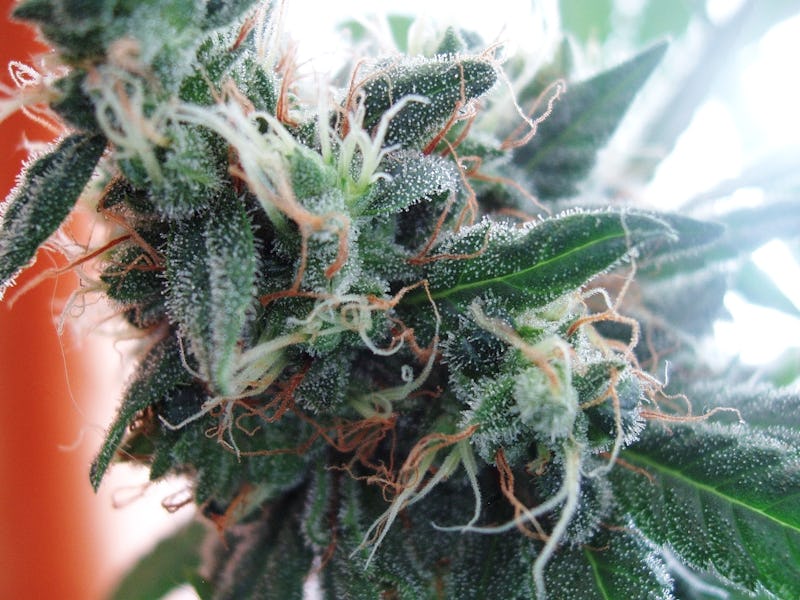What the Hell Is a Terpenoid?
The flavorful terpene oils in cannabis could be just as important as the THC for getting you high.

Nutty with a buttercream finish. Fruity with earthen undertones. If wine nuts weren’t insufferable enough, now we have flavor wheels for all the different strains of pot out there (those descriptions were for Bubba Kush and El Niño, respectively).
While most of the alleged strains of weed out there are more or less made up, there is a wealth of flavorful ingredients naturally found in marijuana called terpene oils, closely related chemically to compounds called terpenoids. Without these terpenes, your jazz cabbage would have no smell and no flavor at all.
And while terpenoids and terpene oils provide the aromas and flavors of countless plants, recent scientific investigations suggest that all the terpene oils in the devil’s lettuce are responsible for so much more. And while everyone knows that the THC in pot is what gets you high, very little is known about terpenes.
Part of the problem is the federal ban on cannabis research. Colleen Hughes, a representative at Pharmacannis, a New York-based medical marijuana dispensary, tells Inverse that even in states with robust medical cannabis programs, the federal ban has been a huge obstruction for researchers who want to learn more about terpene oils and jazz cabbage in general. While some states like Pennsylvania are writing special regulations that protect relationships with institutes and third party labs from federal interference, these programs are still in the early stages and can’t actually guarantee that the federal government won’t try to prosecute growers.
In general terms, terpenes — both terpene oils and terpenoids — are strong smelling oils produced by a vast multitude of plants and some animals. They’re one of the most abundant and varied classes of organic molecules in the world. In fact, there are about 25,000 terpenoids alone. If you’re not cool with the chronic, terpenes are also of particular relevance to growing high-quality teas. And when it comes to the pot that that dude down the block was totally growing in his basement, terpene oils are created and secreted by the same gland, called a trichome, that creates the high-inducing cannabinoids like THC.
In some plants, cannabis included, the pungent odors of the terpene oils emanating from tiny, bubble-like structures called trichomes provide a protective mechanism that keeps hungry herbivores at bay. Or, for the refined drug-haver, the variety of terpenes that can be harvested make for the supposed plethora of pot strains that have allowed growers to assemble pot flavor wheels, like this interactive wheel that matches strain to aroma and alleged therapeutic effect.
Each different strain contains different terpenes, yielding varied aromas and effects.
But unlike most of the garbage claims on the internet about how marijuana is the only medicine we need, an exhaustive review of medical literature reveals that terpenoids do in fact have some medical properties. While pharmaceutical companies are interested in researching terpenoids for all sorts of uses, the chemicals are particularly well-known for their ability to help prevent or fight colon cancer. For example, carvacrol, a terpenoid found in oregano (that stuff you unknowingly bought back in high school) helped rats in a clinical trial kill off the uncontrolled growth of tumor cells.
Many of the terpenes found in pot have alleged medical effects, from the anti-inflammatory effects of β-myrcene to D-linalool’s potential application in treating seizures. But because cannabis research faces so many hurdles, it’s hard to conclusively determine which terpenes do what and to what extent.
“We understand the importance of terpenes and cannabinoids outside of the main THC and CBD compounds, and we formulate our products to include the beneficial terpenes and other cannabinoids that are present in the specific genetics we cultivate,” says Hughes.
Medicine aside, terpenes are thought to have a major role to play in the cannabis experience as well. It’s thought that the medley of terpenes present in each hit can balance out the effect of THC and might reduce the paranoia that some people experience while high.
“There are so many endocannabinoids and compounds in the plant that work synergistically with each other and terpenes that balance each other,” says Hughes. “Until the federal government really opens up, it’s gonna be a challenge for this to really come to light.”